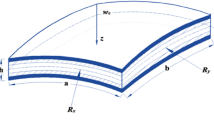Summary
A series of non pathological human tibial and femoral bones have been tested in torsional loading at high strain rates.
Elastic (torsional stiffness) and ultimate properties (T max) have been determined. A geometrical description of the individual bone structures has been performed by determination of the polar moment of inertia (assuming axial symmetry), variation of this parameter along the long axis of the bone and length of the specimen between the grips.
A fairly accurate prediction of mechanical behaviour of bone structures could be obtained using these geometrical parameters.
The high variation of elastic and ultimate properties of whole bone structures in torsional loading is primarily the result of the high variation of polar moment of inertia for the different bone specimens.
Similar content being viewed by others
References
Azang E, Posch P, Engelbrecht R (1972) Experimentelle Untersuchungen über die Bruchfestigkeit des menschlichen Schienbeins. Monatsschr Unfallheilk 25:336
Burstein AH, Currey JD, Frankel VH, Reilly DT (1972) The ultimate properties of bone tissue: The effects of yielding. J Biomechanics 5:35
Burstein AH, Frankel VH (1971) A standard test for laboratory animal bone. J Biomechanics 4:155
Cameron JR, Maress RB, Sorenson JA (1968) Precision and accuracy of bone mineral determination by direct photon absorptiometry. Invest Radiol 3:11
Currey JD (1970) The mechanical properties of bone. Clin Orthop 73:210
Ehler E, Lösche H (1970) Die menschliche Tibia unter Biegebelastung. Beitr Orthop 291
Ehler E, Lösche H (1970) Biegeversuch am menschlichen Femur. Beitr Orthop 304
Evans FG (1973) Mechanical properties of bone. Ch Tomas
Frankel VH, Burstein AH (1965) Load capacity of tubular bone. In: Kenedi RM (ed) Biomechanics and related bioengineering topics. Pergamon Press, Oxford, p 381
Knese KH, Hahne O, Biermann H (1956) Festigkeitsuntersuchungen an menschlichen Extremitätenknochen. Gegenbaur Morph Jahib 96:141
Martens M, Van Audekercke R, De Meester P, Mulier JC (1980) The mechanical behaviour of the long bones of the lower extremity under torsional loading. J Biomechanics 13:667
Mather BS (1968) Variation with age and sex in strength of the femur. Med Biol Engng 6:129
Minns RJ, Bremble GR, Campbell (1975) The geometrical properties of the human tibia. J Biomechanics 8:253
Motoshima T (1960) Studies on the strength for bending of human bony extremity bones. J Kyoto Pref Univ Med 68:1377
Orne D, Young DR (1976) The effects of variable mass and geometry, pretwist, shear deformation and rotatory inertia or the reasonant frequencies of intact long bones: a finite element model analysis. J Biomechanics 9:763
Reilly DT, Burstein AH (1974) The mechanical properties of bone. J Bone Jt Surg 56-A:1001
Reilly DT, Burstein AH, Frankel V (1975) The elastic and ultimate properties of compact bone tissue. J Biomechanics 8:393
Rybicki EF, Simonen FA, Weis EB (1972) On the mathematical analysis of stress in the human femur. J Biomechanics 5:203
Viano D, Helfenstein V, Anlicker M, Rüegsegger P (1976) Elastic properties of cortical bone in female human femurs. J Biomechanics 9:703
Author information
Authors and Affiliations
Additional information
Supported by grant nr. 300071.76—Fonds voor Geneeskundig Wetenschappelijk Onderzoek
Rights and permissions
About this article
Cite this article
Martens, M., Van Audekercke, R., De Meester, P. et al. The geometrical properties of human femur and tibia and their importance for the mechanical behaviour of these bone structures. Arch. Orth. Traum. Surg. 98, 113–120 (1981). https://doi.org/10.1007/BF00460798
Received:
Issue Date:
DOI: https://doi.org/10.1007/BF00460798




